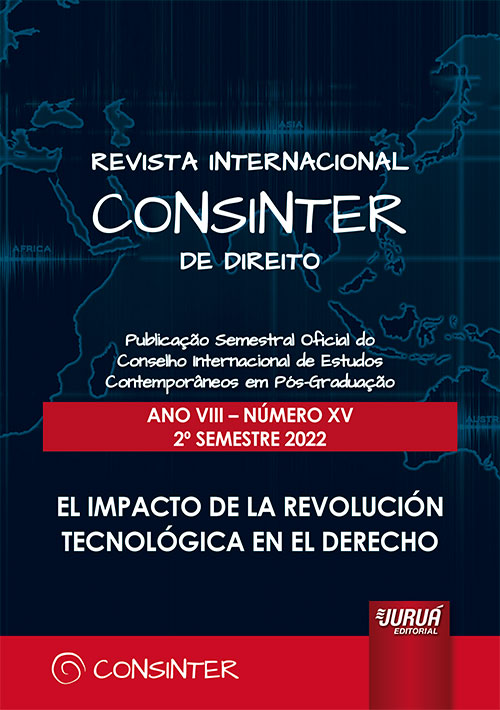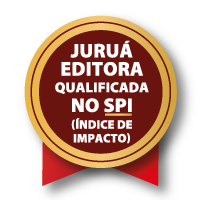The Indigenous Lands, the Protection According to the Current Constitution and the Infra-Constitutional Rules, Their Boundaries and the Conflict in the Exploitation
DOI:
https://doi.org/10.19135/revista.consinter.00015.18Keywords:
Indigenous lands, Constitution, infra-constitutional rules, delimitation, exploitationAbstract
The Federal Constitution from 1988 like any other before, protects the indigenous people, the same way the infra-constitutional rules do. In accordance with this Constitution, the private jurisdiction belongs to the Union when it comes to regulate the indigenous population. Likewise, the constitutional text concedes to the aborigines the right of social organization, customs, language, beliefs and traditions, and also the right to the land that they occupy, when the Union takes the responsibility to mark the territory, protect it and enforce the respect to all their goods.
The Federal Constitution from 1988 saying (article 231), lands traditionally occupied by the Indians are those by them populated in a permanent aspect, used to their productive activities, those indispensable to the preservation of natural resources, needed to the welfare and to the physical and cultural reproduction, according to the usage, customs, and traditions. To these lands, it is allowed the exclusive enjoyment of the riches of the earth, rivers and lakes that are available there. These lands compose the Union’s wealth, and they are inalienable and nondisposable, and the right over them imprescriptible. The utilization of the water resources, including the energy potential, the research and usage of mineral wealth in indigenous lands can only be realized with an authorization from the National Congress.
Downloads
References
AMADO, Frederico, Direito Ambiental, 11ª edição, Editora JusPodivm, 2020.
ANTUNES, Paulo de Bessa, Direito Ambiental, 22ª edição, Editora Atlas, 2021.
CESARINO, Pedro, Histórias Indígenas dos tempos antigos, Editora Claroenigma, 2015.
CUNHA, Manuela Carneiro da; BARBOSA, Samuel, Direitos Dos Povos Indígenas Em Disputa, Editora Unesp, 2018.
FARIAS, Talden; TRENNEPOHL, Terence, Direito Ambiental Brasileiro, Editora RT, 2021.
LENZA, Pedro, Direito Constitucional Esquematizado, 25ª edição, Editora Saraiva, 2021.
MACHADO, Paulo Affonso Leme, Direito Ambiental Brasileiro, 24ª edição, Editora Malheiros, 2016.
MILARÉ, Édis, Direito do Ambiente, 12ª edição, Editora RT, 2020.
RAMOS, André de Carvalho, Curso de Direito Humanos, 3ª edição, Editora Saraiva, 2016.
Direitoindigena.blogspot.com; 9/12/2013 (data de acesso:28/1/2022).
http://www4.planalto.gov.br/legislacao/: (data de acesso:17/7/2021)
https://blog.jazida.com/os-principais-minerios-do-brasil/#:~:text=Como%20visto%20no%20post%20Mi nera%C3%A7%C3%A3o,a%20produ%C3%A7%C3%A3o%20mineral%20brasileira%20comercializada.: 9/10/2019 (data de acesso:12/3/2022)
https://cimi.org.br/2021/07/vitoria-movimento-indigena-pressiona-anglo-american-desiste-27-autoriza coes-pesquisa-cobre-territorios/:13/7/2021 (data de acesso:13/7/2021)
https://dimensoesdasustentabilidade.blogspot.com/: 9/7/2016 (data de acesso:9/2/2022)
https://direito.mppr.mp.br/modules/conteudo/conteudo.php?conteudo=248 (data de acesso:28/1/2022).
https://docplayer.com.br/145358724-Indios-e-meio-ambiente.html; 2019 (data de acesso:28/1/2022).
https://educa.ibge.gov.br/jovens/conheca-o-brasil/populacao/20506-indigenas.html (data de acesso: 28/1/2022)
https://www.camara.leg.br/ (data de acesso:12/3/2022)
https://www.camara.leg.br/busca-portal?contextoBusca=BuscaProposicoes&pagina=1&order=relevanci a&abaEspecifica=true&filtros=%5B%7B%22tipoSituacaoProposicao%22%3A%22Pronta%20para%20Pauta%22%7D%5D&q=pl%20490%2F07&tipos=PL: 17/7/2021
https://www.gov.br/funai/pt-br/assuntos/noticias/2021/instrucao-normativa-ndeg-9-2020-permite-a-funai-avancar-na-area-de-gestao territorial#:~:text=de%20gest%C3%A3o%20territorial-,Instru%C3%A7%C3%A3o%20Normativa%20n%C2%B0%209%2F2020%20permite%20%C3%A0%20Funai,na%20%C3%A1rea%20de%20gest%C3%A3o%20territorial&text=%22Com%20a%20normativa%2C%20s%C3%B3%20permanecem,conflitos%20por%20territ%C3%B3rio%20no%20campo.: (data de acesso:7/7/2021)
https://www.oeco.org.br/reportagens/mineracao-em-terras-indigenas-a-proposta-do-governo-bolsonaro-em-10-perguntas-e-respostas/: (data de acesso:(9/2/2020)
https://www.planalto.gov.br/ccivil_03/Constituicao/Constituicao.htm: (data de acesso:12/03/2022)
https://www.questoesgratis.com/questoes-de-concurso/questoes/assunto=1174?assunto=1174 (data acesso:24/3/2022)
https://www.questoesgratis.com/questoes-de-concurso/questoes/assunto=1174?assunto=1174&%3bpage=2 (data de acesso:24/3/2022)
https://www.questoesgratis.com/questoes-de-concurso/questoes/assunto%3d1174?assunto=1174 (data visualização:24/3/2022)
Published
How to Cite
Issue
Section
License

This work is licensed under a Creative Commons Attribution-NonCommercial-ShareAlike 4.0 International License.
For universalization and free sharing of knowledge, CONSINTER Journal is indexed under the Creative Commons 4.0 License
Attribution – Non-Commercial Use – Sharing by the same 4.0 Brazil license.
It’s allowed:
– Copy, distribute, display and execute the work
– Create derivative works
Under the following conditions:
ATTRIBUTION
You must give credit to the original author, as specified by the author or licensor.
NON-COMMERCIAL USE
You may not use this work for commercial purposes.
SHARING BY THE SAME LICENSE
If you change, transform, or create another work based on it, you may only distribute the resulting work under a license identical to this one.
For each new use or distribution, you must make clear to others the license terms for this work.
Legal License (full license): https://creativecommons.org/licenses/by-nc-sa/4.0/deed.pt_BR









